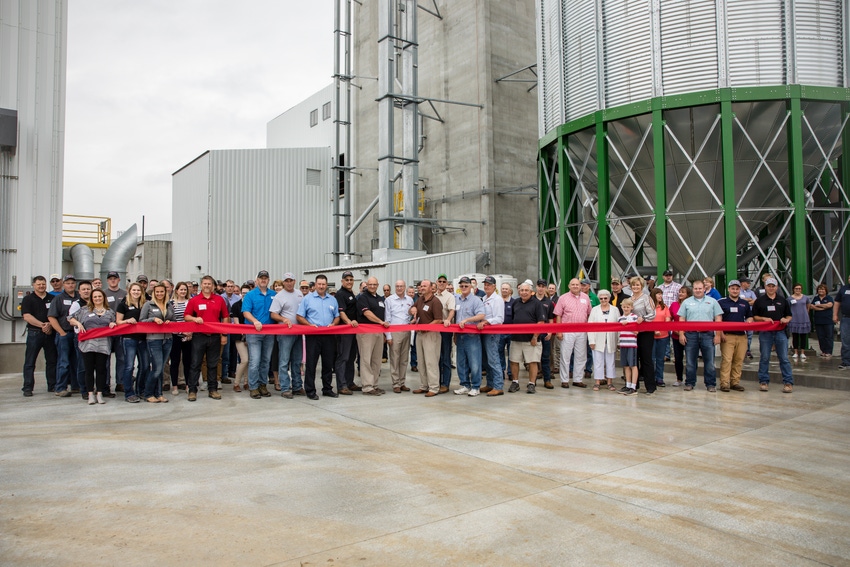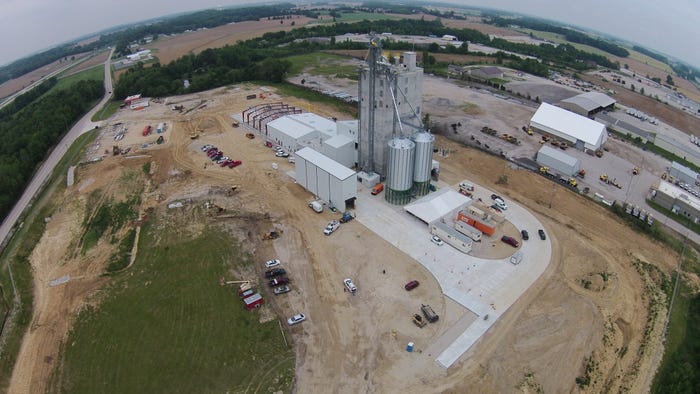Superior Ag cuts ribbon on new feed mill
Cooperative builds $20 million, state-of-the-art feed mill in Dale, Ind., to meet FSMA requirements.
May 19, 2018

Superior Ag held a ribbon cutting May 18 for its new feed mill in Dale, Ind.
Bruce Kettler, director of the Indiana State Department of Agriculture, was the keynote speaker. Also providing a few words during the ceremony were Kathy Reinke, executive director of Spencer County Chamber of Commerce, and Tom Utter, executive director of Lincolnland Economic Development Corp.
Construction for the feed mill began in January 2017 by WL Portland as the general contractor. The $20 million project represents new job opportunities and economic growth for southern Indiana and the entire cooperative footprint, Superior Ag said in an announcement. The feed mill can produce 3,000 tons of livestock nutrition weekly and provide bagged or bulk feed and supplements. The mill features a new pelleting line and an automated bagging and stacker system. It will help ensure that all animal nutrition federal health and safety regulations are met.
Animal nutrition production is scheduled to begin in the middle of June 2018, Superior Ag said.
“Our feed milling operations are continuously growing due to customer and consumer demand. The new feed mill will promote efficiency, reduce costs and provide local farms with enhanced livestock nutrition,” Barry Day, president and chief executive officer of Superior Ag, said. “The new facility will enable us to keep our costs competitive in our ongoing efforts to provide superior value to our member-customers through consistent delivery of high-quality products, innovation and service.”
Food safety is driving regulations and standards, hence the construction of Superior Ag’s new feed mill facility. The publication of the Food Safety Modernization Act (FSMA) in 2015 meant that animal nutrition facilities must comply with Current Good Manufacturing Practices standards, the cooperative said. Dates to comply with FSMA rules are based on the size of the facility, and Superior Ag must comply by September 2018 to meet preventive control requirements. FSMA requires animal nutrition facilities to have a food safety plan in place that incorporates the analysis of hazards to determine control and risk-based preventative controls to minimize and prevent hazards.
In 2016, Superior Ag’s board of directors made the decision to invest in the construction of a new facility. To be compliant with the FSMA regulations, the upgrades alone on the cooperative's current facilities would far exceed the cost of the new facility, the announcement noted.
With the new facility, Superior Ag will be able to grow its Livestock Nutrition business. A new and advanced facility, increased pelleting capacity, added ingredients, higher-quality products and more purchasing power will allow Superior Ag to provide more specialized animal nutrition to local producers and member-customers.

Drone view of Superior Ag's new Dale feed mill on May 18. The production at the facility is expected to start in mid-June.
Operations at Superior Ag’s current feed mill locations in St. Meinrad and Jasper, Ind., will merge into the Dale location.
Superior Ag’s new Dale feed mill is an investment made to produce animal nutrition for the next 60-plus years, the cooperative said.
Superior Ag is a cooperative controlled by a local farmer-member board. It provides a full range of coverage and responsive service to local farmers in its cooperative footprint in southwestern Indiana, northern Kentucky and the bordering regions of Illinois.
Superior Ag combines state-of-the-art equipment, well-trained and motivated employees and environmentally friendly practices to help member-customers meet the unique demands of business.
Superior Ag remains committed to the cooperative way of doing business, where the members own the company, guide the decision-making process and share the benefits – such as increased purchasing power, collective marketing strength and profit sharing – that come from working together within all divisions: Agronomy, Grain, Livestock Nutrition and Energy.
You May Also Like



